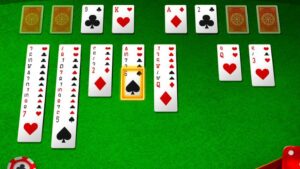Solitaire stands among the most timeless and satisfying single-player card games ever created. For generations, players have shuffled, stacked, and sorted their way through decks, seeking the calm balance of logic and luck that solitaire provides. With its blend of strategy and patience, solitaire offers a moment of focus and peace whether played with a real deck on a quiet afternoon or through sleek digital interfaces on modern devices.
The digital era has revolutionized solitaire into a universal pastime. From the classic Klondike solitaire to Spider solitaire, FreeCell, and the newer solitaired experiences, players can explore dozens of variations, each with unique rules and levels of challenge. You can play on Switch Free Game & Add in the rising popularity of word-based games like Phrazle, and the world of solitaire has expanded into a fascinating mix of traditional and modern gaming elements. Let’s explore everything from the origins and rules to the strategies, online platforms, and mental benefits that make solitaire a truly evergreen game.
What Is Solitaire?
Origins and History
The roots of solitaire trace back to 18th-century Europe, where it was known as “patience.” The game was initially played using physical cards as a meditative pastime, often enjoyed alone or in small social circles. Over time, solitaire gained cultural significance, appearing in literature and parlor games, before eventually crossing the Atlantic and gaining worldwide recognition.
Solitaire as a Patience Game
The term “patience” perfectly captures the game’s essence. Solitaire rewards deliberate, careful planning rather than impulsive moves. Each game presents a unique challenge, requiring focus, observation, and long-term thinking. The quiet rhythm of flipping, building, and moving cards mirrors mindfulness, making solitaire both a relaxing and mentally engaging experience.
Why Solitaire Is So Popular
Part of solitaire’s enduring popularity comes from its accessibility. It requires no opponent, minimal setup, and offers immediate engagement. Players of all ages can learn quickly yet continue discovering depth through advanced strategies. In the digital world, free solitaire versions have turned this simple card game into a global phenomenon, with millions playing daily on phones, tablets, and PCs.
Digital Evolution: From Cards to Screen
The leap from physical decks to solitaire online platforms brought endless possibilities. Players can now switch between Spider solitaire, Klondike solitaire, and FreeCell in seconds. Digital versions feature statistics, auto-complete, undo options, and daily challenges creating an ecosystem where the classic patience game thrives in a modern format.
Popular Solitaire Variants
Klondike (Classic Solitaire)
Klondike solitaire is the most iconic version. Players build tableau columns in descending order, alternating colors, while aiming to transfer all cards to four foundation piles sorted by suit from Ace to King. Its simple structure, combined with strategic card movement, makes it the “default” solitaire in many apps and operating systems.
Spider Solitaire
Spider solitaire introduces deeper complexity. It uses two decks and allows sequences of cards in descending order (King to Ace) to be removed once completed in the same suit. It offers multiple difficulty levels from one-suit beginner mode to the challenging four-suit setup that demands long-term strategy and planning.
FreeCell
Unlike other forms, FreeCell lays all cards face-up at the start, making every move visible. With four open “cells” for temporary storage, players rely on logic rather than luck. Almost every deal in FreeCell can be solved, which appeals to those who enjoy puzzles and deterministic problem-solving.
Solitaired and Lesser-Known Versions
The term solitaired often refers to a collection of solitaire-style games available online. These may include Pyramid, TriPeaks, Yukon, or Double Solitaire. Each version tweaks the fundamental mechanics adding time limits, multi-deck gameplay, or special moves that keep the genre fresh and exciting.
Rules & Setup for Key Variants
Klondike Rules & Setup
A Klondike game starts with seven tableau piles. The first has one card face-up; each subsequent pile has one more card, with only the top card face-up. The remaining deck forms the stock. Players draw from the stock and move cards to the tableau or foundations following alternating-color, descending-order rules. Success depends on freeing hidden cards early and creating space for Kings.
How Spider Solitaire Works
Spider solitaire begins with ten tableau columns and uses 104 cards (two decks). Depending on difficulty, one, two, or four suits are used. The goal is to arrange cards in descending order by suit. When a complete sequence (King to Ace) is formed, it’s automatically removed. New cards are dealt in waves to every column, which adds strategic layers and risk management.
FreeCell Mechanics & Open Cells
FreeCell challenges the player to build sequences by alternating colors, moving cards using the four “free cells.” Each free cell acts as a temporary storage area. The more cells you free, the greater your flexibility. Skilled players learn to anticipate several moves ahead, visualizing how each shift opens new opportunities.
Special Rules in Solitaired / Variants
In solitaired collections, variations may adjust draw counts (one-card draw vs. three-card draw), add reshuffles, or include scoring systems. Some versions introduce timers, streak multipliers, or hint-based systems. These rules maintain engagement for both casual and competitive players, blending traditional and modern gameplay.
Strategy & Tips to Win
General Tactics
Winning at solitaire often hinges on patience and foresight. A few universal strategies include:
- Prioritize uncovering hidden cards early.
- Build evenly across tableau columns to keep options open.
- Avoid moving Kings to empty spaces too soon.
- Use the “undo” or “hint” features in solitaire online to explore safer alternatives.
Klondike Strategy Tips
In Klondike solitaire, never rush to move cards to the foundation; they might be needed to alternate colors. Reveal hidden cards strategically and keep space available for new sequences. Small choices in the early game often determine victory.
Spider Solitaire Strategy Approaches
For Spider solitaire, focus on clearing columns early. Avoid mixing suits unnecessarily, and build sequences of the same suit whenever possible. Dealing new cards too early can trap progress, so ensure every column has at least one movable card first.
FreeCell Advanced Techniques
FreeCell rewards planning ahead. Avoid filling all free cells simultaneously; each empty cell exponentially increases your mobility. Try building temporary sequences in free cells and only transfer to foundations when a full chain can be cleared efficiently.
Playing Solitaire Online / Free
Benefits of Free Online Play
Free solitaire platforms make the game universally accessible. Players can practice multiple variants, track stats, and enjoy adaptive difficulty without cost. This easy availability fuels its popularity across all age groups.
Features to Look For
Quality solitaire online experiences include undo options, hints, auto-finish, leaderboards, and design themes. Some even simulate card textures or animations for tactile satisfaction. Modern interfaces adapt to mobile and desktop devices seamlessly.
HTML5/Browser-Based vs. App-Based
Browser-based solitaire runs instantly on any device without installation. Apps, on the other hand, offer offline play, customization, and achievements. Both deliver solitaired experiences, catering to different preferences.
Offline or Mobile Play
Offline solitaire apps allow players to enjoy games during travel or downtime. With no ads or loading delays, they provide uninterrupted immersion — a digital escape back to the analog calm of traditional card play.
Solitaired & the “Phrazle” Connection
What Is Solitaired?
Solitaired refers to platforms offering an extensive range of card-based patience games. They often feature hundreds of solitaire variations, from classic to experimental. Players can switch modes, track personal stats, and learn from interactive tutorials.
Understanding Phrazle in This Context
Phrazle adds an interesting twist a logic and word-based game related to pattern recognition and deduction, much like solitaire requires with cards. Its presence among solitaire-related searches reflects the broader rise of solo puzzle entertainment.
Variants Under the Solitaired Umbrella
Common solitaired variants include TriPeaks, Pyramid, Yukon, Forty Thieves, and Golf Solitaire. Each uses unique layouts and rules but follows the core solitaire principle of sequential organization and problem-solving.
Why They Matter in the Solitaire Ecosystem
These variations keep solitaire vibrant and adaptable. From Spider solitaire’s intricate planning to Phrazle’s puzzle-solving, the genre has grown beyond cards into a universal symbol of focus, patience, and quiet victory.
Common Challenges & How to Overcome
Unwinnable Deals & the Luck Factor
Not every solitaire game can be won, especially in Klondike and Spider variants. Recognizing when a deal is lost saves time and frustration. Each shuffle brings new possibilities — and the unpredictability keeps the experience fresh.
Stuck Positions and Undo / Backtracking
Digital solitaire online tools provide undo features, letting players revisit moves. Using this wisely teaches pattern recognition and decision-making, transforming every game into a mini strategy lesson.
Best Practices to Avoid Dead Ends
Experienced players always scan the tableau before moving. Avoid covering useful cards and keep color alternation balanced. Every move should aim to expose hidden cards or open new tableau spaces.
Mental & Cognitive Benefits
Playing solitaire strengthens concentration, pattern recognition, and memory. Studies link patience games with improved problem-solving and stress reduction — making it as beneficial as it is entertaining.
Choosing the Best Solitaire Variant for You
Based on Time Available
For quick sessions, FreeCell and Pyramid offer short, decisive rounds. If you prefer longer, thoughtful gameplay, Spider solitaire or multi-deck solitaired versions are ideal.
Based on Challenge vs. Simplicity
New players often start with Klondike solitaire, while veterans lean toward Spider or Yukon for deeper challenges. The level of visible information and randomness defines the difficulty.
For Mobile vs. Browser Users
Mobile users appreciate responsive touch controls and smooth animations, whereas browser players value quick access. Both deliver high-quality free solitaire experiences tailored to device convenience.
For Competitive vs. Casual Play
Competitive players chase win streaks and time records, while casual ones enjoy relaxing sessions. The flexibility of solitaire online ensures everyone finds their rhythm, from speedruns to leisurely Sunday games.
Conclusion
Solitaire continues to inspire both casual gamers and puzzle enthusiasts. From Spider solitaire’s complexity to FreeCell’s logic and the expansive world of solitaired variants, it remains a cornerstone of solo gaming. Whether you play free solitaire during breaks or master Klondike solitaire online, the game delivers timeless satisfaction through strategy, patience, and personal achievement. Its evolution into the digital age ensures solitaire will always be there ready to challenge, relax, and entertain one card at a time.



